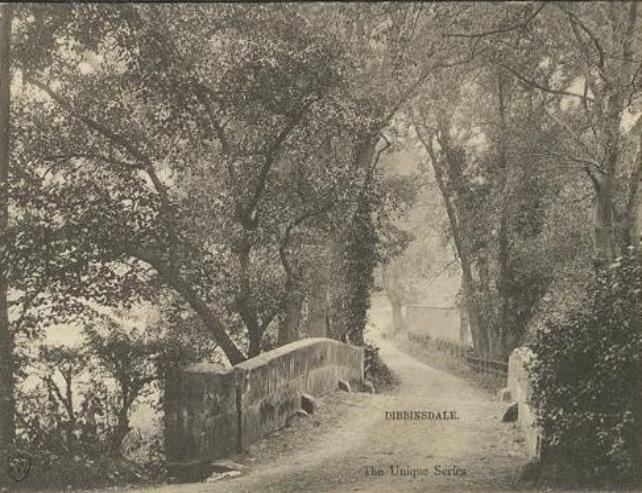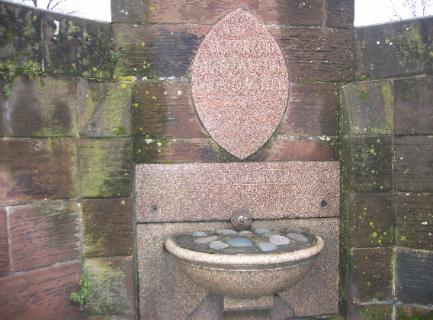






| MENU |


Modern Day Bromborough
Bromborough today is like many of the now over populated villages across the country and again like
many, it also has its problems. One advantage that Bromborough does have over many others is its
local nature reserve. Brotherton Park and Dibbinsdale Nature Reserve comprises of 81 acres of natural
countryside along the river valley of the Dibbin. The valley woodland represents the largest and one of
the finest examples of ancient woodland on Merseyside. The rest of the reserve consists of meadows,
stimulating environment for educational visits. A wide range of activities to suit all age groups can be
carried out on the reserve, in which pupils can develop skills in many curricular areas, particularly science
and geography.
The history of the nature reserve can be traced back as follows.
In 1861 Robert Rankin of Bromborough and David McIver of Brombrough Hall purchased much of the
open land at Dibbinsdale, east of the railway. Woodslee House was built after the land was sold by The
Rev S.K. Mainwaring to a Liverpool Merchant Mr. Robert Rankin in 1866. This was a wedding present to
his daughter when she married Mr David McIver mentioned above who was a shipping magnate. The
house which was completed in 1878, stood near the present car park on a flat area between the
present buildings known as Woodslee Cottages and the edge of the valley. The Yew trees mark the
edge of the garden behind the house which faced east towards the Monkey Puzzle Tree. Woodslee
Cottages, the servants quarters, stables and coach house still stand. There is also a lodge near the
entrance to the park. Lord Brotherton (Edward Allen Brotherton of Wakefield) purchased the Beyer
Company dyestuffs factory in Magazine Road, Bromborough in 1917. He also purchased the Woodslee
Estate two years later with the intention of setting up a Chemical Research Laboratory under the name
Port Rainbow. However, due to cheap imports from Germany after World War 1 he changed his mind
and in 1919 he converted the buildings at Woodslee into flats and cottages for his key employees and
the grounds became known as Brotherton Sports Club. The facilities provided by the club consisted of
cricket and bowling areas with pavilions and two tennis courts. The Chief Chemist at the Brotherton
Works was a Mr.J.H.Wilson who lived for a while in one of the ground floor flats at Woodslee. His son,
Harold, became one of the first sixth form pupils at Wirral Grammar School and went on to become Prime
Minister. Around 1930 Brotherton donated part of the park to Bebington Borough Council which is now
part of Wirral Borough Council. In 1950 Brotherton sold the council the rest of the park including
Woodslee House. Several years later the council decided to demolish the house but the cottages and
stables still remain. 1963 Bebington Borough Council purchased some land west of the railway, now
called Spital Fields. The woodland was cleared and the area used as a municipal waste tip, the extent
of which was increased in 1972. The area was then grassed over and some areas were planted with
trees. This is now a recreational area with a fitness trail. 1979 Most of Dibbinsdale and some of the
areas upstream and the ClatterBrook were designated as a 'Site of Special Scientific Interest' (SSSI) by
the Nature Conservancy Council, now English Nature. 1981 A Ranger service was established by the
Wirral Borough Council to manage Brotherton Park and Dibbinsdale (which is leased from the
Lancelyn-Green family). In 1983 Brotherton Park and Dibbinsdale was designated a Local Nature
Reserve and managed to maintain and enhance wildlife and landscape whilst maintaining public access
to date. Building work began in 1993 on the Woodslee stables to convert them to a visitor centre and
rangers office and workshops.
The picture below shows a postcard of the Dibbinsdale Bridge from 1916. The bridge still stands today
and looks very similar to the picture below.
Bromborough today is like many of the now over populated villages across the country and again like
many, it also has its problems. One advantage that Bromborough does have over many others is its
local nature reserve. Brotherton Park and Dibbinsdale Nature Reserve comprises of 81 acres of natural
countryside along the river valley of the Dibbin. The valley woodland represents the largest and one of
the finest examples of ancient woodland on Merseyside. The rest of the reserve consists of meadows,
stimulating environment for educational visits. A wide range of activities to suit all age groups can be
carried out on the reserve, in which pupils can develop skills in many curricular areas, particularly science
and geography.
The history of the nature reserve can be traced back as follows.
In 1861 Robert Rankin of Bromborough and David McIver of Brombrough Hall purchased much of the
open land at Dibbinsdale, east of the railway. Woodslee House was built after the land was sold by The
Rev S.K. Mainwaring to a Liverpool Merchant Mr. Robert Rankin in 1866. This was a wedding present to
his daughter when she married Mr David McIver mentioned above who was a shipping magnate. The
house which was completed in 1878, stood near the present car park on a flat area between the
present buildings known as Woodslee Cottages and the edge of the valley. The Yew trees mark the
edge of the garden behind the house which faced east towards the Monkey Puzzle Tree. Woodslee
Cottages, the servants quarters, stables and coach house still stand. There is also a lodge near the
entrance to the park. Lord Brotherton (Edward Allen Brotherton of Wakefield) purchased the Beyer
Company dyestuffs factory in Magazine Road, Bromborough in 1917. He also purchased the Woodslee
Estate two years later with the intention of setting up a Chemical Research Laboratory under the name
Port Rainbow. However, due to cheap imports from Germany after World War 1 he changed his mind
and in 1919 he converted the buildings at Woodslee into flats and cottages for his key employees and
the grounds became known as Brotherton Sports Club. The facilities provided by the club consisted of
cricket and bowling areas with pavilions and two tennis courts. The Chief Chemist at the Brotherton
Works was a Mr.J.H.Wilson who lived for a while in one of the ground floor flats at Woodslee. His son,
Harold, became one of the first sixth form pupils at Wirral Grammar School and went on to become Prime
Minister. Around 1930 Brotherton donated part of the park to Bebington Borough Council which is now
part of Wirral Borough Council. In 1950 Brotherton sold the council the rest of the park including
Woodslee House. Several years later the council decided to demolish the house but the cottages and
stables still remain. 1963 Bebington Borough Council purchased some land west of the railway, now
called Spital Fields. The woodland was cleared and the area used as a municipal waste tip, the extent
of which was increased in 1972. The area was then grassed over and some areas were planted with
trees. This is now a recreational area with a fitness trail. 1979 Most of Dibbinsdale and some of the
areas upstream and the ClatterBrook were designated as a 'Site of Special Scientific Interest' (SSSI) by
the Nature Conservancy Council, now English Nature. 1981 A Ranger service was established by the
Wirral Borough Council to manage Brotherton Park and Dibbinsdale (which is leased from the
Lancelyn-Green family). In 1983 Brotherton Park and Dibbinsdale was designated a Local Nature
Reserve and managed to maintain and enhance wildlife and landscape whilst maintaining public access
to date. Building work began in 1993 on the Woodslee stables to convert them to a visitor centre and
rangers office and workshops.
The picture below shows a postcard of the Dibbinsdale Bridge from 1916. The bridge still stands today
and looks very similar to the picture below.

There are still many signs of the old days dotted around Bromborough. None more so than the cross
which contains the oldest dwellings in the area, an ancient cross, a Victorian drinking fountain, the old
school hall and St Barnabas church including the Saxon Cross. Below is a selection of pictures from
around the cross area:
which contains the oldest dwellings in the area, an ancient cross, a Victorian drinking fountain, the old
school hall and St Barnabas church including the Saxon Cross. Below is a selection of pictures from
around the cross area:




| Right: The Old School House c1868 |
Left: Pear Tree
Cottage
Cottage
| Right: Cottages |
Left: Victorian
drinking fountain.
drinking fountain.